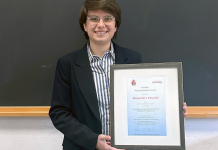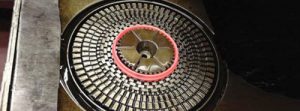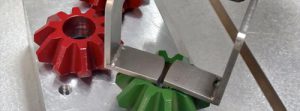Aqueous inorganic salt quenchants
In this column, I will discuss the inorganic salt quenchants and how they can be used effectively to quench lean hardenability steel parts.
Often, a...
Determining the agitation needed in a quench tank
In this column, I will review the basic requirements of agitation, and illustrate a method of determining the right amount of agitation.
Recently, a customer...
Polymer quenchants and corrosion of aluminum
When slow quenching 2024 aluminum, this alloy is susceptible to intergranular corrosion. Two common quenchants, water and AMS 3025 PAG type quenchants, are compared.
Introduction
Heat...
Thermal expansion of mineral oil quenchants
In this column, I will discuss the thermal expansion of oil. This information is primarily important for initial fills of a quench tank.
Introduction
Oil, when...
The effect of catalysts on quench oil oxidation
In the last column, I discussed the effect of temperature on the oxidation of a quench oil. As was alluded to in my last...
Effect of temperature on oxidation of oil quenchants
In this column, I will discuss the effect of temperature on the oxidation behavior of martempering oil used for distortion control.
Introduction
Martempering oils are used...
The mechanism of creep and its stages
In this column, I will discuss the mechanism of creep and its three stages.
Applications of metals at elevated temperatures involve several problems. It is...
Intergranular corrosion of austenitic stainless steels
In this column, I will discuss the intergranular corrosion of austenitic stainless steels (3XX) and discuss the thermal processing causes.
Introduction
Austenitic stainless steels, such as...
Cooling rate after tempering
In this column, I will discuss the effect of cooling rate after tempering.
Introduction
During heat treatment of steel, the process is generally austenitize, quench, and...
Intergranular oxidation in carburizing steels
Intergranular oxidation (IGO) in carburizing steels is detrimental to carburized gear performance. It reduces fatigue performance and can contribute to surface spalling. This article...
Hardening power: A measure of quenching performance
In this column, we will discuss the Segerberg Hardening Power (HP) for polymer quenchants.
When comparing polymer quenchants, there are several things that we look...
Calculating decarburization
In this column, I will be talking about decarburization of steel and how to calculate its depth.
Introduction
Decarburization of steel is the depletion of carbon...
The effect of temperature on cooling curve behavior
In this column, we will discuss the effect of temperature on the cooling curve behavior of quench oils.
Development of Quench Oil Maximum Operating Temperature
The...
The effect of agitation on oil quenchants
In this column, I will discuss the effect of agitation on the cooling curve of oil quenchants.
Oil has been used for many years as...
Quenching from molten salt into polymer quenchants
In this column, I will discuss quenching aluminum from molten salt into a polymer quenchant.
A molten salt bath is a common method of heating...
Blistering of aluminum during heat treatment
In this column, we will discuss the blistering of aluminum during heat treatment, and methods to prevent its occurrence.
Introduction
High-temperature oxidation, or blistering, often occurs...
Quench factor analysis: C-curve determination
Previously, I discussed the concept of the quench factor, as developed by Staley . We showed that it was possible to determine properties as...
Quench factor analysis: quench factor determination
In this column, we will discuss the determination of the quench factor as it is used in quench factor analysis. This will lead into...
Quench Factor analysis used to predict properties of quenched and aged aluminum
In this column, we will start to discuss the application of Quench Factor Analysis (QFA) to predicting properties of quenched and aged aluminum.
Quench Factor...
Control of distortion in heat-treated aluminum
In this column, we will discuss controlling the distortion of aluminum heat-treated components.
The heat treatment of aluminum (solution heat treatment, quenching and aging) are...
Heat-treating workhorse – integral quench furnace
In this column, we will discuss the workhorse of the steel heat-treating industry – the integral quench furnace.
The integral quench furnace, or sealed quench...
Understanding the effect of boron in steels
In this column, we will discuss the effect of boron additions to steel and its influence on properties.
Boron, B, is an element with an...
Safety considerations when quenching with oil or salt
In this column, we will consider safety aspects of quenching with oil or molten salt.
Heat treating is a manufacturing process where the goal is...
Classifying non-metallic inclusions in steels
In this column, we will discuss the different types of inclusions present in steels and discuss their physical metallurgy. As property requirements increase, and...
Revisiting the 1:1 Rule for oil quenchants
The rule of thumb “one gallon of oil to one pound of parts and fixtures” has been in the literature for a long time....
Quench tank agitation by submerged jets
In this column, I will discuss agitation by submerged jets.
Common methods of agitating quench tanks, and other types of tanks, are by sparging or...
Influence of agitation on polymer quenchants
Polymer quenchants are used extensively to quench a large variety of materials in a variety of processes. Polymer quenchants can be used for immersion...
Sampling of quench oil for proactive maintenance
In this column, I will discuss the sampling of quench oil for quarterly checks as required by many internal and external auditing agencies (CQI-9,...
Compatibility of polymer quenchants with metals, seals
In this column, I will discuss the compatibility of polymer quenchants and materials used in the construction of quench tanks, heat exchangers, and pump...
Using water as a quenchant
In this short column, we will discuss quenching with water. As a quenching medium, plain water approaches the maximum cooling rate attainable in a...
Understanding the basics of spray quenching
Spray quenching involves the removal of heat by the impingement of a liquid quenchant on a hot metal surface. Examples include:
Fog quenching.
Quenching...
Estimating required flow through quench tanks
In this month’s column, I will discuss a method of estimating the required flow for a quench tank.
Agitation has a significant effect on...
Use of molten salts for martempering of steel
In July’s column, I talked about molten salts and the different types. In this short column, we discuss the benefits of using molten salts...
Use of molten salt in heat treatment
At the turn of the 20th century, the use of molten salt as a heating and quenching medium for steels was developed in England....
Finding data needed for modeling and simulation
Modeling and simulation have become an important part of the design and manufacturing toolbox. Modeling and simulation are used in forging, casting, machining, forming,...
Thermal separation of polyalkylene glycol quenchants
Polyalkylene glycol quenchants are used in a variety of different heat-treating applications. One very common application is quenching of large steel and aluminum components....
Heat treatment of aluminum Part VII – Hardness and conductivity
In the previous article, we discussed the artificial aging of aluminum. Once we have heat treated the parts, we need to verify the properties....
Heat treatment of aluminum VI – Artificial aging
In the previous column, we described the fundamentals of natural aging. In natural aging, the solid solution obtained after quenching starts to form precipitates...
Heat treatment of aluminum, Part V
After quenching and any straightening, the supersaturated solid solution of aluminum wants to reach equilibrium. It does this through the process of precipitation hardening....
Heat treatment of aluminum IV: Handling distortion
After quenching, depending on the quenchant used, distortion of parts can occur. This is particularly true for water-quenched parts. Parts must be straightened. This...
























